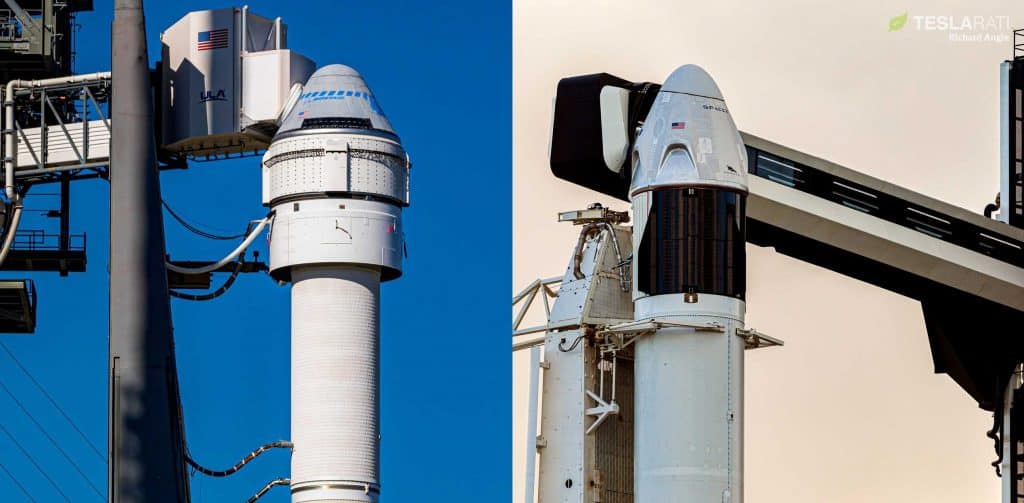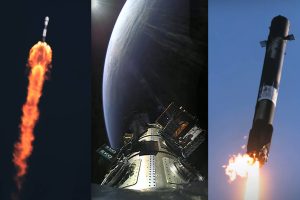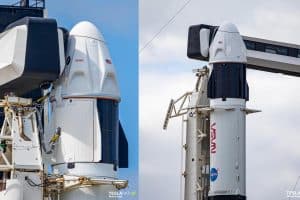Russia has invaded Ukraine without provocation, triggering a series of diplomatic responses – sanctions in particular – that recently culminated in the aggressor deciding to cut ties with Europe on a number of cooperative spaceflight projects.
Dmitry Rogozin, director of Russia’s national ‘Roscosmos’ space agency, went as far as implying that the country might respond to the West’s aerospace sanctions by ending its support of the International Space Station (ISS), a move that could cause the football-field-sized structure to gradually deorbit and reenter Earth’s atmosphere. Were it not for the existence of two extraordinarily successful NASA programs and SpaceX in particular, Russia’s response – which, today, reads like a child’s tantrum – could easily have been a grave threat with far-reaching consequences.
In response to sanctions after its unprovoked invasion, Russia announced that it was withdrawing support from Europe’s French Guinea Soyuz launch operations, effectively killing Arianespace’s Soyuz offering and potentially delaying several upcoming European launches indefinitely.
As a quick side note, it’s worth noting that ULA’s lack of readily available rockets and the fact that Arianespace is likely at least a year or more away from regular Ariane 6 launches means that SpaceX may be the only Western launch provider in the world capable of filling in the gap that Arianespace’s Soyuz loss will leave. Aside from pursuing Chinese launch services, which is likely a diplomatic non-starter, the only alternative to rebooking former European Soyuz payloads on SpaceX rockets is to accept one or even several years of expensive delays.
On the other half of the coin is the International Space Station. NASA signed its first major contract with SpaceX in 2008, awarding the company $1.6 billion (and up to $3.5 billion) to launch a dozen Cargo Dragon supply missions to the ISS. Aside from effectively pulling SpaceX back from the brink of dissolution, those funds also covered a large portion of the development of its Falcon 9 rocket and Dragon spacecraft and simultaneously funded Orbital Science’s (later Orbital ATK and now Northrop Grumman) Cygnus cargo spacecraft and Antares rocket.
Despite suffering two failures in 2014 and 2015, NASA’s Commercial Resupply Services (CRS) program has been an extraordinary success. Together, Cygnus (17) and Dragon (24) have completed 41 deliveries in the last 12 years, carrying more than 110 tons (~240,000 lb) of cargo to the ISS.
Out of sheer coincidence, on February 19th, mere days before Russia’s act of war, Northrop Grumman launched the first Cygnus spacecraft designed to help ‘re-boost’ (raise the orbit of) the International Space Station. Since NASA’s premature 2011 retirement of the Space Shuttle, that task has been exclusively conducted by a combination of Russian spacecraft and the station’s Russian Zvezda module. Without regular Russian re-boost support, the station would deorbit and be destroyed. In other words, if push came to shove, the ISS could very literally fail without direct Russian involvement. Rogozin’s threat, then, was that Russia might cease to support ISS re-boosting if sanctions went too far.
However, even while ignoring the fact that NASA itself actually paid for and owns the ISS Zvezda propulsion module and in light of the first Cygnus spacecraft upgraded with a re-boost capability berthing with the station the very same week of the invasion, Russia’s threat rang decidedly hollow. Further, if Cygnus weren’t available, it’s still difficult to imagine that SpaceX wouldn’t be able to quickly develop its own Dragon re-boost capability if asked to do so.
While re-boosting is crucial, the situation has also emphasized just how little leverage Russia now has over even more important aspects of the International Space Station. Were it not for the existence of SpaceX and NASA’s Commercial Crew Program (CCP), the situation could be even direr for Europe and the US. Despite some pressure from lawmakers to only award the CCP contract to Boeing, NASA ultimately selected Boeing and SpaceX to develop independent crew capsules capable of carrying US astronauts to and from ISS in 2014. Following a near-flawless uncrewed Crew Dragon test flight in 2019 and an equally successful crewed demo mission in 2020, SpaceX completed its first operational Crew Dragon launch in November 2020.
Since then, SpaceX has launched another two operational ‘crew rotation’ missions, meaning that the company has now singlehandedly supported all US astronaut launch and recovery operations for 16 months. Due in part to extensive mismanagement, Boeing’s Starliner spacecraft was nearly destroyed twice during its first catastrophic uncrewed test flight in December 2019. The spacecraft is still months away from a second attempt at that test flight, likely at least 9-12 months away from a hypothetical crewed test flight, and potentially 18+ months away from even less certain operational NASA astronaut launches. Further, though ULA CEO Tory Bruno claims that the company doesn’t need any support from Russia, all Atlas Vs – the rocket responsible for launching Starliner – depend on Russian-built RD-180 engines.
Further adding to the mire, even Cygnus is not immune. The first stage of the Antares rocket that mainly launches it is both built in Ukraine and dependent upon Russian Energomash RD-181 engines. Northrop Grumman only has the hardware on hand for the next two Cygnus-Antares launches, at which point the company will have to either abandon its NASA contract or find an alternative launch provider. Once again, SpaceX is the only US provider obviously capable of filling that gap on such short notice and without incurring major delays of half a year or more.

In fewer words, without SpaceX, NASA would still be exclusively dependent upon Russian Soyuz rockets and spacecraft to get its astronauts to and from the space station it spent tens of billions of dollars to help build. Even in a best-case SpaceX-free scenario, NASA might instead be dependent upon a rocket with Russian engines to launch its own astronauts. Needless to say, the presence of US astronauts on Russian launches and ULA’s use of Russian engines were already extremely sensitive issues after Russia ‘merely’ invaded Ukraine’s Crimea region in 2014.
It’s hard not to imagine that US and European responses to Russia’s aggression would have been weakened if NASA and ESA astronauts were still entirely dependent upon Russia to access the International Space Station. Further, in the same scenario, given its withdrawal from French Guinea, it’s also not implausible to imagine that Russia might have severely hampered or even fully withdrawn its support of Western access to the ISS.
Put simply, Crew Dragon – now a bastion of independent European and US human spaceflight in an age of extraordinary Russian recklessness – has arguably never been more important and SpaceX’s success never more of a triumph than they are today.





